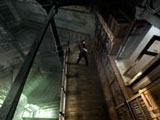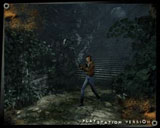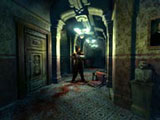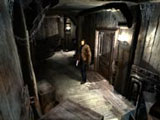 Let’s be frank here: the
survival-horror genre has gone through some cool innovations since the genre took off back
in the mid-nineties (remember those days?), but at its heart it is still the basic
situation. We’ve all been there-- stranded on an island/mansion/deserted town where
devils/zombies/mutants roam free and demon dogs snipe at your heels (every survival-horror
game’s gotta have a demon dog). For some video game characters, it’s an average
weekend romp. So, don’t play Alone in the Dark: The New Nightmare for a new twist;
play it because it does everything established in the genre right. With a compelling story
line, kick-arse graphics, and sound effects that make you want to wet your pants in fear,
Alone in the Dark delivers a good time. Unfortunately, it also falls into the trap of
having terrible voice acting and impossibly difficult-to-kill enemies. This bumps the game
down to a three star rating
Let’s be frank here: the
survival-horror genre has gone through some cool innovations since the genre took off back
in the mid-nineties (remember those days?), but at its heart it is still the basic
situation. We’ve all been there-- stranded on an island/mansion/deserted town where
devils/zombies/mutants roam free and demon dogs snipe at your heels (every survival-horror
game’s gotta have a demon dog). For some video game characters, it’s an average
weekend romp. So, don’t play Alone in the Dark: The New Nightmare for a new twist;
play it because it does everything established in the genre right. With a compelling story
line, kick-arse graphics, and sound effects that make you want to wet your pants in fear,
Alone in the Dark delivers a good time. Unfortunately, it also falls into the trap of
having terrible voice acting and impossibly difficult-to-kill enemies. This bumps the game
down to a three star rating The fourth in the long running
series, Alone in the Dark: The New Nightmare continues the spooky if non-original style
prevalent in most survival-horror game’s story lines. Shadow Island is the location
where Edward Carnby, the series hero, must go when he finds out his best friend has been
found dead. Aline Cedrac, a cute doctor of archaeology, tags along with Carnby to also
investigate the disappearance of Obed Morton, a famous yet creepy archaeologist. On one
fine dark and storm night, Carnby and Cedrac decide to fly to the island, but as they pass
overhead, something stops them mid-flight, and they are both forced to jump from the
plane. Carnby lands in a forest and Cedrac lands on (gasp!) a creepy haunted mansion. From
that point on you get the choice between Carnby and the babelicious Aline Cedrac; both
have different paths through the same old game.
The fourth in the long running
series, Alone in the Dark: The New Nightmare continues the spooky if non-original style
prevalent in most survival-horror game’s story lines. Shadow Island is the location
where Edward Carnby, the series hero, must go when he finds out his best friend has been
found dead. Aline Cedrac, a cute doctor of archaeology, tags along with Carnby to also
investigate the disappearance of Obed Morton, a famous yet creepy archaeologist. On one
fine dark and storm night, Carnby and Cedrac decide to fly to the island, but as they pass
overhead, something stops them mid-flight, and they are both forced to jump from the
plane. Carnby lands in a forest and Cedrac lands on (gasp!) a creepy haunted mansion. From
that point on you get the choice between Carnby and the babelicious Aline Cedrac; both
have different paths through the same old game.
 The
graphic quality and detail are AITD’s most impressive features, especially from a PC
port. Like most games of its kind, scenery and backgrounds are pre-rendered. However, due
to the high resolution of the Dreamcast, the differences are negligible between the moving
polygonal characters and the backgrounds. Your main heroes of choice are rendered in
awesome detail; you can even notice patterns in the fabric of the clothing. Like most
sassy heroines of this genre, Aline Cedrac comes ready for adventure in her stylish
leather jacket, low-cut tank top shirt, and a pair of jeans that must have been painted on
her. Every single female I showed this game to reacted in disgust as Cedrac walked down
spooky hallways while inhumanly swinging her hips to and fro. I got a kick out of it
myself.
The
graphic quality and detail are AITD’s most impressive features, especially from a PC
port. Like most games of its kind, scenery and backgrounds are pre-rendered. However, due
to the high resolution of the Dreamcast, the differences are negligible between the moving
polygonal characters and the backgrounds. Your main heroes of choice are rendered in
awesome detail; you can even notice patterns in the fabric of the clothing. Like most
sassy heroines of this genre, Aline Cedrac comes ready for adventure in her stylish
leather jacket, low-cut tank top shirt, and a pair of jeans that must have been painted on
her. Every single female I showed this game to reacted in disgust as Cedrac walked down
spooky hallways while inhumanly swinging her hips to and fro. I got a kick out of it
myself.
 The
effects that really shine (pun semi-intended) are the light source effects. You start off
with a flashlight that can be aimed in any direction you want, and it actually illuminates
objects. The lighting source is fantastic and adds realism to an already detailed game.
However, when there’s an important object in a room that needs to be examined, it
usually sparkles like a beacon—no matter what the object actually is. You spend most
of your time shining your light in random directions hoping for a sparkle from some
grenades, not very realistic at all.
The
effects that really shine (pun semi-intended) are the light source effects. You start off
with a flashlight that can be aimed in any direction you want, and it actually illuminates
objects. The lighting source is fantastic and adds realism to an already detailed game.
However, when there’s an important object in a room that needs to be examined, it
usually sparkles like a beacon—no matter what the object actually is. You spend most
of your time shining your light in random directions hoping for a sparkle from some
grenades, not very realistic at all.
 Gameplay
in AITD is pretty standard. If you have a powerful gun, you shoot things; if you
don’t, you run away. The original games in the series were based on hardcore puzzle
solving and true supernatural enemies. Resident Evil, released just three years after the
first AITD, has set the standard for survival-horror games. To be frank, AITD: The New
Nightmare plays like a modified Resident Evil: it looks better, responds quicker, and adds
a flashlight. Other than that, you’ll swear you’ve seen the monsters in other
games and its like déjà vu’ all over again when you find keys randomly scattered
around. AITD, the great innovator back in the early nineties, is now following the trend.
Gameplay
in AITD is pretty standard. If you have a powerful gun, you shoot things; if you
don’t, you run away. The original games in the series were based on hardcore puzzle
solving and true supernatural enemies. Resident Evil, released just three years after the
first AITD, has set the standard for survival-horror games. To be frank, AITD: The New
Nightmare plays like a modified Resident Evil: it looks better, responds quicker, and adds
a flashlight. Other than that, you’ll swear you’ve seen the monsters in other
games and its like déjà vu’ all over again when you find keys randomly scattered
around. AITD, the great innovator back in the early nineties, is now following the trend.
 It’s
a good game nonetheless. Because of the whole theme of "darkness", some of the
creatures in the game can be scared off by your flashlight, which offers at least a
different way of disposing of enemies. Light carries an important meaning throughout the
game as some of your weapons are based off of light. Sometimes your flashlight can help
you solve the few puzzles there are in the game. Eventually the "gee-whiz"
factor of having a flashlight wears off, and you just wish the flashlight worked on the
bigger zombie-looking guys.
It’s
a good game nonetheless. Because of the whole theme of "darkness", some of the
creatures in the game can be scared off by your flashlight, which offers at least a
different way of disposing of enemies. Light carries an important meaning throughout the
game as some of your weapons are based off of light. Sometimes your flashlight can help
you solve the few puzzles there are in the game. Eventually the "gee-whiz"
factor of having a flashlight wears off, and you just wish the flashlight worked on the
bigger zombie-looking guys.
Like stated above AITD follows the Resident Evil bandwagon and controls are no
exception. I’ve never played a game of this genre that didn’t have semi-sluggish
controls, and it’s a real atrocity when slow sauntering mutants maul you because you
back up too slow. At least it’s easy to compensate (avoid corners). The menu system,
while not intuitive, does give you more control. With the press of a button, a mini-menu
pops up that lets you activate your walkie-talkie, map, or inventory. The inventory is
grouped into convenient sections for easy access to any weapon or item. A single button
click gets you out of there, too. Pressing the R trigger button automatically readies your
gun for shooting, and auto aim is also implemented to make shooting a semi-breeze.
Enemies aren’t plentiful but they always show up at the most inconvenient times.
They come in three main sizes: annoying demon dog like creatures, annoying zombies, and
insanely cheap bosses. Enemy AI, overall, is viscous and unrelenting. Once you’re in
the same room as an enemy, they’ll pester you until you leave. There’s a strange
bug, though: sometimes creatures get stuck in certain spots and, well, just spin in
circles or attack a wall. Ammo is strewn all over, and this gives the illusion of being
equipped to handle the situation, but all is not as it seems. It takes a lot of stopping
power to even escape from a sticky situation. The magnum you get at the start of the game
becomes a little popgun not far into the game. The weapon you’ll use the most is a
triple barrel shotgun, and that means three times the amount of ammunition used. With this
much ammo lost, it’s better to run than fight.
Horrible voice acting is used in this game and not sparingly either. All the in-game
movies include either flat monotone voices or way overacted ones. Some people say this
gives it a "B-movie" feel, but I say someone is just cheap and won’t hire
good actors. More than any other game, AITD pours on the sound effects. You’ll hear
random groaning and howls, even some that get louder as you get closer to a room. Usually,
you can hear an enemy before you even see it, though a lot of that is because of some
wacky camera angles that can cause a wall to occupy half of the screen.
AITD fails to be innovative anymore, with much of its features having long since been
done to death in previous games. This DC title, however, is a steal at $19.99. If you
can’t find Resident Evil: Code Veronica,
give this game a whirl. Just don’t expect much.
